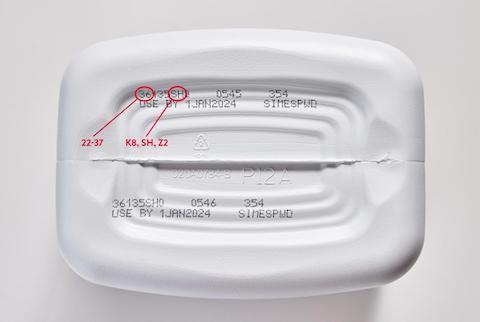The FDA is advising consumers not to use Similac, Alimentum or EleCare powdered infant formulas if:
the first two digits of the code are 22 through 37 and
the code on the container contains K8, SH, or Z2, and
the expiration date is 4-1-2022 (APR 2022) or later

The FDA, along with CDC and state and local partners are investigating four consumer complaints of infant illness related to products from Abbott Nutrition’s Sturgis, MI facility received from 9/6/2021 to 12/18/2021. All of the cases are reported to have consumed powdered infant formula (IF) produced from Abbott Nutrition’s Sturgis, MI facility. These complaints include three reports of Cronobacter sakazakii infections and one report of Salmonella Newport infection in infants. All four cases related to these complaints were hospitalized and Cronobacter may have contributed to a death in one case.
Total Adverse Events: 5 (4 Cronobacter, 1 Salmonella)
Hospitalizations: 5
Reported Deaths: 2
Adverse Event Dates: 9/16/2021 – 1/4/2022
States with Adverse Events: MN (1), OH (2), TX (2)
Product Distribution: Nationwide and International
FDA has initiated an onsite inspection at the facility. Findings to date include several positive Cronobacter results from environmental samples taken by FDA, and adverse inspectional observations by FDA investigators. A review of the firm’s internal records also indicate environmental contamination with Cronobacter sakazakii and the firm’s destruction of product due to the presence of Cronobacter.
FDA is issuing this advisory to alert consumers to avoid purchasing or using certain powdered infant formula produced in the Sturgis, MI facility.
This is an ongoing investigation and the firm is working with the FDA to initiate a voluntary recall of potentially affected product. FDA is continuing to investigate and will update this advisory should additional consumer safety information become available.
The code is printed on the product packaging near the expiration date (see product image below). Additional information on products made by Abbott Nutrition is available on their website: https://www.similacrecall.com/...
Products that do not contain the information listed above are not impacted by this advisory. This advisory does not include liquid formula products or any metabolic deficiency nutrition formulas. Consumers should continue to use all product not covered by this advisory.
Products made at the Sturgis facility can be found across the United States and were likely exported to other countries as well.
These powdered infant formulas have the potential to be contaminated with Cronobacter, a bacterium that can cause severe foodborne illness primarily in infants. Cronobacter infections are rare but are especially high risk for newborn infants (see symptoms below).
Parents and caregivers should never dilute infant formula and should not make or feed homemade infant formula to infants.
If your regular formula is not available, contact your child’s healthcare provider for recommendations on changing feeding practices.
More information on Cronobacter and infant formula is available on CDC’s website.
Cronobacter bacteria can cause severe, life-threatening infections (sepsis) or meningitis (an inflammation of the membranes that protect the brain and spine). Symptoms of sepsis and meningitis may include poor feeding, irritability, temperature changes, jaundice (yellow skin and whites of the eyes), grunting breaths, and abnormal movements. Cronobacter infection may also cause bowel damage and may spread through the blood to other parts of the body.
Salmonella: Marler Clark, The Food Safety Law Firm, is the nation’s leading law firm representing victims of Salmonella outbreaks. The Salmonella lawyers of Marler Clark have represented thousands of victims of Salmonella and other foodborne illness outbreaks and have recovered over $800 million for clients. Marler Clark is the only law firm in the nation with a practice focused exclusively on foodborne illness litigation. Our Salmonella lawyers have litigated Salmonella cases stemming from outbreaks traced to a variety of foods, such as cantaloupe, tomatoes, ground turkey, salami, sprouts, cereal, peanut butter, and food served in restaurants. The law firm has brought Salmonella lawsuits against such companies as Cargill, ConAgra, Peanut Corporation of America, Sheetz, Taco Bell, Subway and Wal-Mart.
If you or a family member became ill with a Salmonella infection, including Reactive Arthritis or Irritable bowel syndrome (IBS), after consuming food and you’re interested in pursuing a legal claim, contact the Marler Clark Salmonella attorneys for a free case evaluation at 1 800 884-9840.